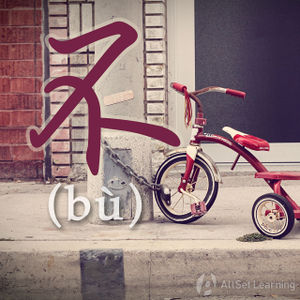Difference between revisions of "Expressing "not only... but also" with "budan... erqie...""
| Line 3: | Line 3: | ||
"不但⋯⋯,而且⋯⋯" (bùdàn..., érqiě...) is a very commonly used pattern that indicates "not only, ... but also...." | "不但⋯⋯,而且⋯⋯" (bùdàn..., érqiě...) is a very commonly used pattern that indicates "not only, ... but also...." | ||
| − | == Structure == | + | == One Subject == |
| + | |||
| + | === Structure === | ||
<div class="jiegou"> | <div class="jiegou"> | ||
| Line 15: | Line 17: | ||
The pattern can also be used omitting 而且, and instead using adverbs like 也 and 还 in its place. | The pattern can also be used omitting 而且, and instead using adverbs like 也 and 还 in its place. | ||
| − | == Examples == | + | === Examples === |
<div class="liju"> | <div class="liju"> | ||
| Line 25: | Line 27: | ||
*他 <em>不但</em> 能 修 汽车,<em>还</em> 能 修 自行车 。<span class="trans">He not only can fix cars, but can also fix bicycles.</span> | *他 <em>不但</em> 能 修 汽车,<em>还</em> 能 修 自行车 。<span class="trans">He not only can fix cars, but can also fix bicycles.</span> | ||
*啊!他 很 聪明,<em>不但</em> 上 了 很 好 的 大学,<em>而且</em> 有 很 好 的 成绩。<span class="trans">Wow. He's really smart. Not only did he go to a good university, but he also got really good grades.</span> | *啊!他 很 聪明,<em>不但</em> 上 了 很 好 的 大学,<em>而且</em> 有 很 好 的 成绩。<span class="trans">Wow. He's really smart. Not only did he go to a good university, but he also got really good grades.</span> | ||
| − | |||
</div> | </div> | ||
| − | Different | + | == Two Different Subjects == |
| − | When there is only one subject with 不但⋯⋯而且⋯⋯, the subject has to come before 不但 and 而且 | + | When there is only one subject with 不但⋯⋯而且⋯⋯, the subject has to come at the beginning of the sentence, before both 不但 and 而且. When using two different subjects, however, you need to put one after 不但 and one after 而且. |
== Structure == | == Structure == | ||
| Line 47: | Line 48: | ||
<div class="jiegou"> | <div class="jiegou"> | ||
| − | 不但 + | + | 不但 + Subject 1 + Adj./Verb, 而且 + Subject 2 + Adj./Verb |
</div> | </div> | ||
Revision as of 02:16, 18 February 2014
-
Level
-
Similar to
- Expressing "and" with "he" (A1)
- Expressing "and also" with "hai" (A2)
- Expressing "both A and B" with "you" (A2)
- Expressing "except" and "in addition" with "chule… yiwai" (B1)
- Expressing "in addition" with "haiyou" (B1)
- Expressing "in addition" with "lingwai" (B1)
- Expressing "in addition" with "zaishuo" (B1)
- Advanced uses of "hai" (B2)
- Expressing "not only..., even..." using "budan..., shenzhi lian" (B2)
- Many types of "not only... but also..." (B2)
- Using "budan... geng" to express "not only... but also" (B2)
- Using "er" to explain contrasting ideas (B2)
-
Used for
-
Keywords
"不但⋯⋯,而且⋯⋯" (bùdàn..., érqiě...) is a very commonly used pattern that indicates "not only, ... but also...."
Contents
One Subject
Structure
Subject + 不但 + Adj./Verb, 而且 + Adj./Verb
The same subject should apply to both the first part and the second part (the part after 而且).
The pattern can also be used omitting 而且, and instead using adverbs like 也 and 还 in its place.
Examples
- 他 不但 做 完 了 所有 的 工作 ,而且 做 得 非常 好 。Not only did he finish all the work, but he also did it extremely well.
- 这 种 菜 不但 好吃 ,而且 有 营养 。This kind of vegetable is not only delicious, but nutritious as well.
- 她 不但 会 说 汉语 ,而且 会 说 日语。She can not only speak Mandarin, but can also speak Japanese.
- 这个 学生 不但 会 说 中文 ,而且 中文 说 得 很 好 。Not only can she speak Chinese, but she also speaks it well.
- 他 不但 能 修 汽车,还 能 修 自行车 。He not only can fix cars, but can also fix bicycles.
- 啊!他 很 聪明,不但 上 了 很 好 的 大学,而且 有 很 好 的 成绩。Wow. He's really smart. Not only did he go to a good university, but he also got really good grades.
Two Different Subjects
When there is only one subject with 不但⋯⋯而且⋯⋯, the subject has to come at the beginning of the sentence, before both 不但 and 而且. When using two different subjects, however, you need to put one after 不但 and one after 而且.
Structure
So here's the pattern with one subject:
Subject + 不但 + Adj./Verb, 而且 + Adj./Verb
And here's the pattern with two subjects:
不但 + Subject 1 + Adj./Verb, 而且 + Subject 2 + Adj./Verb
Examples
- 我 不但 会 做饭,而且 会 洗衣服。(One subject)I can not only cook, but she can also do some washing.
- 不但 我 会 做饭,而且 我妹妹 也会 做饭。(Two subjects)Not only I can cook, but also my little sister can.
See also
Sources and further reading
Books
- Common Chinese Patterns 330 (汉语常用格式330例) (pp. 22) →buy
- Modern Mandarin Chinese Grammar: A Practical Guide (pp. 253) →buy
- New Practical Chinese Reader 2 (新实用汉语课本2) (pp. 219) →buy
Websites
- Yale Chinese Usage Dictionary: Usage of 而



